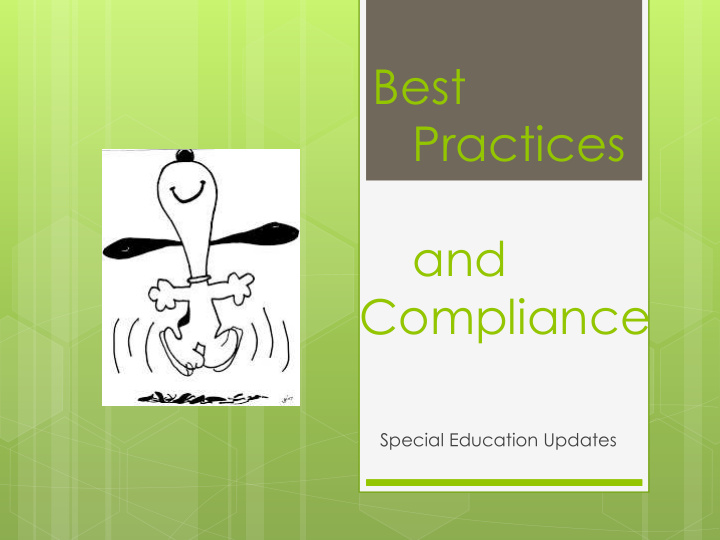



Best Practices and Compliance Special Education Updates
Goals of the Presentation Understand which assessments are required for determining eligibility. Understand the eligibility process for specific learning disabilities. Understand the importance of the nonparticipation justification.
Assessment
Required Assessments The following assessments must be completed by appropriately credentialed and trained specialists for each referred student: Assessment in all areas related to the suspected disability, including consideration of any needed assistive technology devices and services and/or instruction in Braille. Educational assessment by a representative of the school district, including a history of the student’s educational progress in the general curriculum. Assessment by a teacher with current knowledge regarding the student’s specific abilities in relation to learning standards of the Massachusetts Curriculum Frameworks and the district’s general education curriculum, as well as an assessment of the student’s attention skills, participation behaviors, communication skills, memory, and social relations with groups, peers, and adults. For a student being assessed to determine eligibility for services at age three (3), an observation of the student’s interactions in the student’s natural environment or early intervention program is strongly encouraged together with the use of current assessments from Early Intervention Teams to avoid duplicate testing.
Ed Assessment A SCHOOL HISTORY: 1. YEAR GRADE SCHOOL 2. Has the student received any instructional support services? 3. Have there been any school-related events/issues (such as attendance, recognitions, special education referrals, behavioral issues and medical problems) that have impacted upon the student’s learning? EDUCATIONAL PROGRESS AND POTENTIAL: 4. Is the student making progress in the general curriculum? If NO , explain why not and reference the student’s educational history and state/district-wide assessment results when responding. 5. Has the student’s progress been: a. similar to that of his/her peers? If NO , list the possible factors that have enhanced/ limited progress. b. consistent over the student’s school history? If NO , list the possible factors that have enhanced or limited progress. 6. Provide any other comments related to the student’s educational and developmental potential.
Ed Assessment B CURRENT TEACHER ASSESSMENT: 1. Describe the student’s specific abilities in relation to the learning standards of the Massachusetts Curriculum Frameworks and the district curriculum. Attach additional information (e.g. work samples and/or observational data) to support your response. 2. Does the student appear to have attention difficulties? If YES , please explain. 3. Does the student seem to participate appropriately in classroom activities? If NO , please explain. 4. Do the student’s communication skills seem age-appropriate? If NO , please explain. 5. Does the student’s memory appear to adversely affect learning? If YES , please explain. 6. Are the student’s interpersonal skills with groups, peers and adults age-appropriate? If NO , please explain. 7. Comment on any additional factors that influence the student’s performance.
Optional Assessments The Administrator of Special Education may recommend or the parent may request one or more of the following: a. A comprehensive health assessment by a physician that identifies medical problems or constraints that may affect the student's education. The school nurse may add additional relevant health information from the student’s school health records. b. A psychological assessment by a certified school psychologist, licensed psychologist, or licensed educational psychologist, including an individual psychological examination. c. A home assessment that may be conducted by a nurse, psychologist, social worker, guidance or adjustment counselor, or teacher and includes information on pertinent family history and home situations, and may include a home visit, with the agreement of the parent.
SLD
What Is SLD? A disorder in one or more of the basic psychological processes involved in understanding or in using language, spoken or written, that may manifest itself in the imperfect ability to listen, think, speak, read, write, spell, or to do mathematical calculations.
SLD Includes… Perceptual Disabilities Brain Injury Minimal Brain Dysfunction Dyslexia Developmental Aphasia
SLD is NOT… A Visual Disability A Hearing Disability A Motor Disability An Intellectual Disability An Emotional Disability Due to Environment Disadvantage Due to Cultural Diversity Due to Economic Disadvantage
Determining an SLD Discrepancy Model Response to Intervention
Required Components for SLD Determination in MA Historical Review Educational Assessment Area of Concern and Evaluation Method Exclusionary Factors Observation
Guiding Principle In order for a student to be identified as having an SLD, the TEAM needs to demonstrate that the student has had adequate opportunity to learn.
Last Step ALL members of the IEP TEAM must sign in agreement to the eligibility determination of SLD.
Non-Participation Justification
Why Removal from General Ed? If the student is removed from the general education classroom at any time, the TEAM must state why the removal is considered critical to the student’s program and the basis for its conclusion that education of the student in a less restrictive environment, with the use of supplementary aids and services, could not be achieved satisfactorily.
Least Restrictive Programming The program selected must be the least restrictive environment for students, with consideration given to any potential harmful effect on the student or on the quality of services needed. Georgetown Public Schools will not remove an eligible student from the general education classroom solely because of needed modification in the curriculum.
Examples Jackie is removed for all curricular subjects because he requires a small, structured classroom with routine and systematic rewards in order to increase positive behavior and control angry outbursts. Margaret is taken from the general education class because she requires daily ASL instruction and continuous practice in the use of ASL skills to improve communication skills with ongoing opportunities for ASL interaction with peers and adults.
More Examples Given the intensity and unpredictability of Kris’ aggressive and unsafe reactions to real or perceived difficulties with academic challenges or social interactions, he requires removal from class for both his safety and the safety of others. Katelin’s degenerative neuromotor issues require that she be removed from the classroom for direct physical therapy services in a private setting that maximizes her learning experiences.
Questions?
Recommend
More recommend